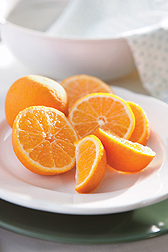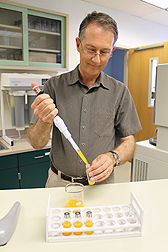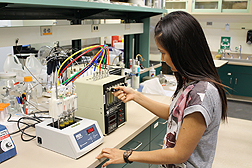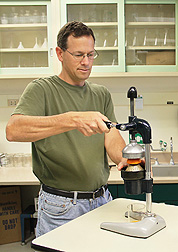Mandarin Oranges: Protecting the Flavor of This Popular Fruit
|
|
Fresh and juicy mandarin oranges are good for you and have a delightfully sweet flavor that makes them a favorite of kids and adults alike.
Whether you know them by brand names such as “Cuties” or “Halos,” or perhaps simply as clementines or tangerines, all are mandarins. And all are high in vitamin C and are a good source of vitamin A.
Agricultural Research Service scientist Dave Obenland at Parlier, California, and horticulturist Mary Lu Arpaia and colleagues at the University of California-Riverside are conducting studies to discover more about mandarin flavor and—equally as important—how to protect it as these oranges make their way from the orchard to the fruit bowl on your kitchen counter.
Their research focuses on uncovering more details about the natural chemicals in mandarins that contribute to the fruit’s pleasing flavor and on determining what causes changes in those flavors after the fruit is put into storage. That new knowledge may help citrus-fruit breeders, and the people who grow, store, ship, or sell the fruit, ensure that the oranges keep their delicious taste.
Chilling Out
Most mandarin oranges that are destined for the produce section of your local supermarket probably spend at least some time in cold storage. Before that happens, however, freshly picked mandarins are typically washed, then sprayed with a thin coating of a wax that’s approved for this food use. The wax helps hold in the fruit’s natural moisture and adds an attractive gloss to its peel.
Next, the oranges are placed in cardboard cartons that are then stacked, in packinghouse storerooms, to await shipment.
The flavor research that Obenland and Arpaia began in 2009 may be among the most extensive of its kind for this specialty citrus fruit. The scientists have now tested more than 19,000 mandarin oranges from at least a half-dozen different research and commercial orchards in California, the state that produces the bulk of the nation’s mandarin harvest.
Individual studies have spanned multiple years and multiple harvests, to take within-year and year-to-year variations into account.
All of their experiments simulate real-world conditions of busy commercial packinghouses or retail settings and encompass a range of time-and-temperature regimens. In some of these tests, for instance, the researchers kept the fruit at cold-storage temperatures of 32, 39, 41, 46, or 50 °F for several weeks and, in some cases, followed that by a week or more of storage at 68 ËšF.
Storage experiments lasted up to 6 weeks and have yielded more than 5,000 data points. The work has included not just the classic W. Murcott Afourer variety, but lesser known ones, as well.
Some storage-related mandarin flavor research, done by scientists elsewhere, “treated cold storage followed by warmer storage as a single regimen,” Obenland says. “We evaluated the effects of the cold-storage period separately from the effects of the warm storage that followed. This work is, to the best of our knowledge, unique among published scientific studies of mandarin flavor. We found that cold-storage temperatures influence flavor in some varieties, but not others.”
An example: The 10 to 17 taste testers that evaluated mandarins for the research reported that the flavor of W. Murcott Afourer fruit stored at 46 °F for 3 to 6 weeks, followed by a week at 68 °F, was “slightly superior” to that of fruit of that same variety stored at 32 or 39 °F, followed by a week at 68 °F. However, the taste testers did not discern a difference in the flavor of Owari variety mandarins that were stored at these regimens.
|
|
What Makes Flavor?
In some experiments, loss of some flavor was attributed to changes in levels of a few specific chemicals. But the exact biological and chemical mechanisms underlying those changes are, for the most part, not well known and are a target of the team’s research.
For instance, the scientists found that statistically significant changes in several flavor-associated chemicals occurred after W. Murcott Afourer mandarins, previously refrigerated at 41 °F, were brought out of the cold and kept at 68 °F.
For that study, Obenland and Arpaia tracked changes in more than two dozen natural chemicals—alcohols, aldehydes, esters, and terpenes, also known as “aroma volatiles”—to learn more about the exact role each may play in the fruit’s flavor profile.
In brief, changes in a class of esters—the ethyl esters—occurred soon after the oranges were taken out of cold storage. Statistically significant increases in three of the four monitored ethyl esters (ethyl acetate, ethyl propanoate, and ethyl 2-methylpropanoate) took place within the first 24 hours after the fruits were moved from cold (41 °F) to warmer (68 °F) storage. What’s more, statistically significant increases in the fourth ethyl ester, ethyl 2-methylbutanoate, took place a day later.
|
|
Interestingly, all four ethyl esters are thought to contribute to a sweet, fruity aroma, which may have a role in what we perceive as flavor.
However, in the case of these ethyl esters, it may be possible to have too much of a good thing. That’s because high levels of these four compounds are suspected of contributing to off-flavor, Obenland says. The team’s ongoing studies may help clarify the impact of these ethyl esters in relation to other natural compounds.
Obenland and Arpaia also looked at two other important groups of flavor-related chemicals—sugars and acids. Their data suggests that increased concentrations of esters and alcohols “may have a greater influence on mandarin off-flavor than the ratio of sugars to acids,” Obenland says.
In new research, the scientists are looking at how flavor of W. Murcott Afourer and nine other mandarin varieties changes after the conventional wax-coating process. The coating limits movement of oxygen into the fruit. That can, in turn, lead to buildup of some flavor chemicals. But Obenland says a change in oxygen levels inside the fruit doesn’t explain every change in flavor.
In these experiments, mandarin varieties that are the least affected by the coating, or not affected at all, may be of the most interest. Their flavor secrets might help make mandarin oranges—already delectable—even better.
The research team’s findings were published in Postharvest Biology and Technology in 2011 and 2013.—By Marcia Wood, Agricultural Research Service Information Staff.
This research is part of Quality and Utilization of Agricultural Products, an ARS national program (#306) described at www.nps.ars.usda.gov.
David M. Obenland is in the Commodity Protection and Quality Research Unit, USDA-ARS San Joaquin Valley Agricultural Sciences Center, 9611 S. Riverbend Ave., Parlier, CA 93648; (559) 596-2801.
"Mandarin Oranges: Protecting the Flavor of This Popular Fruit" was published in the October 2014 issue of Agricultural Research magazine.










